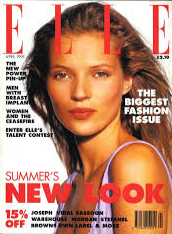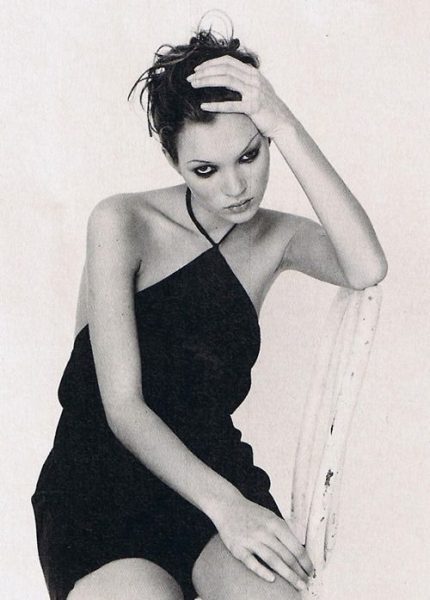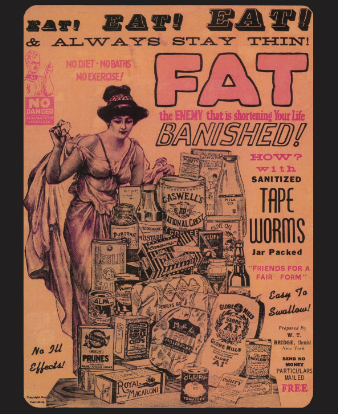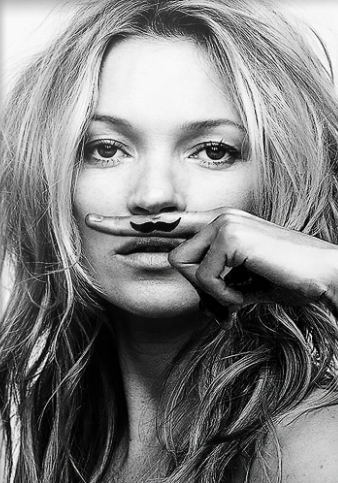Since the start of the fashion industry, supermodels have set societal expectations in an influential way. The lavish lifestyle that models live appears spectacular to an audience, but in reality, it is a result of demented habits and choices. Whether it’s using advertising to promote beauty standards or setting high expectations for a particular body image.
The Start of Heroin Chic

Heroin chic was a look that became popular in the ’90s. It glorified a malnourished body type, dark eye makeup, pale skin, and disheveled hair. Typically, people pair heroin chic and Kate Moss together, and she did have a huge impact on the look as she was promoting it, but she did not start it. American supermodel, Gia Carangi is credited with starting heroin chic. Carangi suffered from heroin abuse and died of AIDS in ’86 at age 26. After her death, Kate Moss rose to fame. Supermodels like Moss filled magazines with what was called an “effortless runway look.” This consisted of thigh gaps, showing defined hip- or collarbones, and slim, flat waists, and it became the desirable look. To maintain this body, many models suffered from anorexia and heroin abuse. According to Heather R. Hayes who specializes in mental health, in the years “between 1990 and 1998” the presence of eating disorders in the US, increased at a high rate in those “aged 15 to 29 and only began to slowly decrease again in 2010.” This suggests that the fashion industry impacted society in a negative way as a result of the popularity of “heroin chic.” Former president Bill Clinton even commented on heroin chic during the ’90s. “You do not need to glamourize addiction to sell clothes,” Clinton remarked. “The glorification of heroin is not creative, it’s destructive. It’s not beautiful; it’s ugly. And this is not about art; it’s about life and death. And glorifying death is not good for any society.”
Kate Moss


Kate Moss was a famous supermodel in the ’90, and she was known for the heroin chic look. In an interview, Moss claimed that she was never anorexic, that she never did heroin, and that she thinks she was simply a “scapegoat for a lot of peoples problems” (Cosmopolitan.com). Other sources have stated they’ve seen her using heroin, so it’s hard to know who to believe. Mentally this must be difficult, because she believes that people blame their problems and illnesses on her. In addition to that, Moss has had scary experiences throughout her career. At just 15 years old, Moss booked a shoot for a catalog where the photographer asked her to take her top off. In response, she stated that she was shy and felt that this was wrong, so she got up and ran away. She has also experienced people manipulating her, even her friend, photographer Corinne Day. Moss stated that she was already “self conscious,” and Day would threaten to ruin her career if Moss didn’t pose the way Day wanted. According to Moss, she would cry after the threats. Moss has also shared a moment during a photo shoot with Mark Wahlberg for Calvin Klein. She stated that Wahlberg was very “macho” and added that besides feeling objectified, she also felt very “vulnerable and scared” during the shoot. The crew apparently played on her vulnerability, stating that she was quite “young and innocent” (El País US Edition). Now, Moss works with her own agency, which she started in 2016. Due to her unique connections, models within her agency can find and develop their own talent with personal management.
Body Image & The Tape Worm Diet
With the rise of supermodels, body image has become a central focus as models walk the runway. Viewers often wonder: How will the model’s body complement the outfit? How will the model convey the designer’s vision? These questions create expectations for models to meet, shaping standards they are often expected to follow.

Models are typically thinner than average, ranging from a size 0-2. In comparison, the average size for an American woman is 16. This discrepancy is mostly due to the industry’s preferences, with a belief that clothing drapes and flows better on models who are “taller and skinnier” (Riordan, 2018). Essentially, when only small sizes are showcased on runways and magazine covers, it can lead to body dysmorphia and constant self-comparison. This emphasis on thinness can also contribute to eating disorders, which many models struggle with. Over 40% of models in the industry suffer or have suffered from an eating disorder. Victoria Secret model Bridgette Malcolm spoke up, saying, “ I struggled when my waist was just 33 inches.” During this time, she also said that she “lost clients – being told that my body did not look good enough”(Malcolm, 2019). She was rejected when she gained half an inch in her hips. This made her feel pressured to change her body and contributed to her developing anorexia.

To avoid Bridgette’s situation, some models are rumored to have ingested tapeworm pills. While no specific models have been directly linked to this illegal practice, several high-profile supermodels reportedly display symptoms associated with tapeworm infection. When these pills are ingested, the worms grow in the stomach and then eat any “extra calories,” keeping the person skinny. Tapeworm infection displays many effects like rapid weight loss, fatigue, exhaustion, and digestive issues, which can lead to cysts. Ingesting tapeworms was extremely popular in the Victorian era for women who wanted to “achieve what that society viewed as beautiful” (Zapata, 2016). Tapeworm diets have seen an increase since the year 2000. A hospitalization for tapeworm infection was reported that year, highlighting the trend. Model Tyra Banks addressed the issue on her talk show, interviewing women who admitted they “would willingly ingest a yellowish worm to lose weight” (Banks, LA Times, 2009). Tapeworm ingestion is believed to be practiced not only by models but also by designers and regular viewers in the fashion community, all aiming to meet industry standards.
Mental Perspective of our Society
Although we admire supermodels and love fashion, we have to realize that there’s a darker side to the industry. Whether that’s the toxic behaviors of individuals or the unhealthy standards set for models. It’s important to remember that you are not alone, and you don’t need to change your body to fit unrealistic expectations or to fit in with “ beauty standards.”
If you or someone you know has struggled with the themes presented above, please contact 741-741 or call 800-950-NAMI.

Works Cited:
- Rittenhouse, Margot. “Models & Eating Disorders.” Eating Disorder Hope, 16 Sept. 2024, www.eatingdisorderhope.com/risk-groups/eating-disorder-models#:~:text=Approximately%2040%25%20of%20models%20engage,be%20much%20higher%20%5B1%5D.
- Wells, Diana. “Tapeworm Diet: Weight Loss, Risks and Side Effects.” Healthline, Healthline Media, 11 June 2019, www.healthline.com/health/diet-and-weight-loss/tapeworm-diet.
- Hayes, Heather. “The Dangerous Revival of ‘Heroin Chic.’” Heather Hayes & Associates, 23 Nov. 2022, www.heatherhayes.com/the-dangerous-revival-of-heroin-chic/.
- Demopoulos, Alaina. “The Term ‘heroin Chic’ Needs to Die – Even If Skinny-Worship Rages On.” The Guardian, Guardian News and Media, 21 Nov. 2022, www.theguardian.com/fashion/2022/nov/20/heroin-chic-fashion-skinny-worship.
- Moda, S. “Kate Moss: ‘I Was Only 15 and He Said, “Take Your Top off” and I Could Feel There Was Something Wrong.’” EL PAÍS English, 26 July 2022, english.elpais.com/society/2022-07-26/kate-moss-i-was-only-15-and-he-said-take-your-top-off-and-i-could-feel-there-was-something-wrong.html.
- “Kate Moss.” Edited by Editor Britannica, Encyclopædia Britannica, Encyclopædia Britannica, inc., 21 Oct. 2024, www.britannica.com/biography/Kate-Moss.
- Biggs, Jade. “Kate Moss Reflects on Her Infamous Line: ‘Nothing Tastes as Good as Skinny Feels.’” Cosmopolitan, 25 July 2022, www.cosmopolitan.com/uk/body/health/a40703565/kate-moss-reflects-nothing-tastes-as-good-as-skinny-feels/.
- “A Diet Aid with an ICK Factor.” Los Angeles Times, Los Angeles Times, 19 Feb. 2007, www.latimes.com/archives/la-xpm-2007-feb-19-he-esoterica19-story.html.
- Zapata, Mariana. “The Horrifying Legacy of the Victorian Tapeworm Diet.” Atlas Obscura, Atlas Obscura, 18 Feb. 2024, www.atlasobscura.com/articles/the-horrifying-legacy-of-the-victorian-tapeworm-diet.
- Mandell, Andrea. “Victoria’s Secret Model Details Struggle with Anorexia, Says Her Hair Began to Fall Out.” USA Today, Gannett Satellite Information Network, 8 Aug. 2019, www.usatoday.com/story/entertainment/celebrities/2019/08/07/victorias-secret-model-bridget-malcolm-reveals-extreme-anorexia/1946535001/.
- Tips, Daily Dev. “Why Are Models so Skinny? The Truth about This Fashion Industry Reality –.” The H Hub, 16 July 2019, thehhub.com/2018/09/12/why-are-models-so-skinny/#:~:text=Many%20designers%20believe%20their%20clothing,look%20as%20beautiful%20as%20possible.




